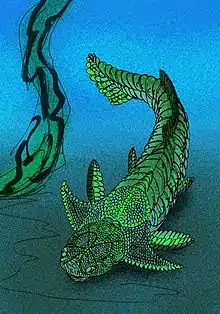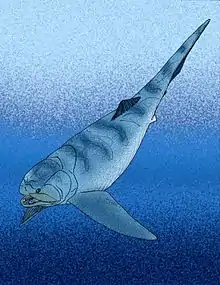Enseosteus
Enseosteus is a genus of small selenosteid arthrodire placoderms known from the Upper Frasnian Kellwasserkalk facies of Late Devonian Germany[1] and Morocco.[2]
| Enseosteus | |
|---|---|
 | |
| E. jaeckeli | |
| Scientific classification | |
| Kingdom: | |
| Phylum: | |
| Subphylum: | |
| Class: | |
| Order: | |
| Suborder: | |
| Infraorder: | |
| Superfamily: | |
| Family: | |
| Genus: | Enseosteus |
| Type species | |
| Enseosteus jaekelli Gross 1932 | |
| Species | |
| |
| Synonyms | |
| |
Enseosteus is very similar to the other Kellwasserkalk selenosteids, though, the type species, E. jaekelli, has a bulbous, knob-shaped rostrum. Denison (1978) synonymizes the genera Ottonosteus (O. jaekeli = E. hermanni) and Walterosteus with Enseosteus, claiming that the two genera are too similar to Enseosteus to merit separate genus status.[1] Rücklin (2011) agrees with Denison's synonymizing of Ottonosteus, but rejects Denison's synonymization of Walterosteus, claiming how Walterosteus has a contact between the rostral plate and the pineal plate, which Enseosteus does not.[2]
References
- Denison, Robert (1978). Handbook of Paleoichthyology, Volume 2, Placodermi. New York: Gustav Fischer Verlage. pp. 96–98. ISBN 9780895740274.
- RÜCKLIN, MARTIN (January 14, 2011). "First selenosteid placoderms from the eastern Anti-Atlas of Morocco; osteology, phylogeny and palaeogeographical implications". Palaeontology. 56 (1): 25–62. doi:10.1111/j.1475-4983.2010.01026.x.
This article is issued from Wikipedia. The text is licensed under Creative Commons - Attribution - Sharealike. Additional terms may apply for the media files.


